TechRadar Verdict
The Samsung Q8F QLED TV has a slim, appealing design, and features the company's Tizen 9.0 smart TV platform, but its black levels are inconsistent, there's no 120Hz or VRR support for gaming and sound quality is sub-par. But price is where the Q8F really struggles, as better-performing mini-LED TVs are available for cheaper.
Pros
- +
Good color
- +
Slim design
- +
Tizen smart TV platform
Cons
- -
Better value mini-LED TVs available
- -
Reflective screen
- -
No 120Hz or VRR support (UK)
Why you can trust TechRadar
Samsung Q8F: Two-minute review
The Samsung Q8F is a mixed bag of a TV. It has a decent array of features, a nice design and solid enough picture quality, but a lack of key gaming features, along with average sound quality, hold it back. And with plenty of budget rival mini-LEDs on the market, such as the TCL C7K, one of 2025’s best TVs, the Q8F’s price is a tough ask.
The Q8F has punchy, vivid colors that look natural in movies, and it offers decent contrast. Once adjusted in the settings, motion handling is good for both movies and sport, and textures mostly appear crisp. However, the screen shows some backlight clouding and raised blacks, and screen reflections are visible in bright viewing conditions.
Sound quality is sub-par on the Q8F. Speech is clear enough, but the soundstage is very narrow, the bass is thin and the volume still feels lacking even when pushed to high levels. You’ll want to get one of the best soundbars for this TV.
For a TV at this price range, the physical design is pretty good. The Q8F is slim, sleek and has easy-to-fit feet that can be put in two positions: wide (for a soundbar) or narrow (for furniture). Plus, it has a trim bezel and Samsung’s rechargeable SolarCell remote.
Tizen 9.0, the latest version of Samsung’s Tizen smart TV platform, is one of the best to date. It has a user-friendly interface, a useful quick menu, tons of customization options and plentiful picture settings. Some settings are buried deep in the menus, however, which can be frustrating if you regularly adjust your picture.
The Q8F is an average gaming display. Performance is good overall and it has a low 9.2ms input lag, but it lacks key features we look for in the best gaming TVs, such as 4K 120Hz and VRR support. It does come with Samsung’s useful Gaming Hub portal, but if you’re looking for a gaming TV at this price, Hisense and TCL’s mini-LED TVs are a better option.
While the Q8F isn’t a badly priced TV, it is a tough sell when better performing mini-LED TVs with more features, specifically for gaming, are available for the same price or less in 50-inch and above, such as the TCL C6K.
Sign up for breaking news, reviews, opinion, top tech deals, and more.
Samsung Q8F review: Price and release date

- Release date: May 2025
- 43-inch: £549
- 50-inch: £699
- 55-inch: £899
- 65-inch: £1,199
- 75-inch: £1,799
- 85-inch: £2,499
The Samsung Q8F is the flagship model in Samsung’s 2025 QLED lineup, sitting above the Samsung Q6F and Q7F. It is available in a wide range of sizes, including a 32-inch model (US only). The 65-inch model I tested launched at £929 in May 2025.
Since its launch, there have been discounts across every screen size, with the 65-inch I tested now priced at £869 on average. You can now find the 55-inch size for £629 and the 75-inch for £1,299.
Samsung Q8F review: Specs
Screen type: | QLED |
Refresh rate: | 60Hz |
HDR support: | HDR10+, HDR10, HLG |
Audio support: | Dolby Atmos |
Smart TV: | Tizen |
HDMI ports: | 3 x HDMI 2.0 |
Samsung Q8F review: Benchmark results
Samsung Q8F review: Features

- Q4 AI Processor
- Tizen smart TV platform
- HDR10+ support
The Samsung Q8F uses a QLED panel and features Samsung’s Q4 AI processor. It supports the HDR10+ high dynamic range format, but like other Samsung TVs does not support Dolby Vision. It also has a Filmmaker Mode picture preset and supports new Samsung TV features such as Color Booster Pro.
The Q8F’s 2-channel, 20W speaker array supports Dolby Atmos along with Samsung audio features such as Active Voice Amplifier and Object Tracking Sound (OTS) Lite. It also supports the Q-Symphony feature, where the TV's speakers can work in tandem with compatible Samsung soundbars.
For gaming, the Q8F supports 4K 60Hz, HGiG, ALLM, and Samsung’s Gaming Hub, a portal for cloud gaming services such as Xbox and Luna. It doesn’t support higher refresh rates such as 120Hz, and there’s also no VRR support. There are only three HDMI ports in total as well.
One thing worth noting is that in the US, the Q8F actually supports 120Hz and VRR. We have reached out to Samsung to find out why the gaming specs are different in the US and UK and will update this review when we receive a reply.
The Q8F features the latest version of Samsung’s Tizen smart TV platform, Tizen 9.0. Along with a Quick Menu where important settings can be easily accessed, Tizen provides tailored recommendations and integration with the Samsung SmartThings smart home platform. It has several new AI features, including one that provides info about the show you’re currently watching, and Samsung TV Plus, which offers hundreds of free ad-supported streaming channels.
UK viewers should note that Samsung TV Plus is included in place of FreeView/Freely, but with the right aerial and satellite cable connections, the usual UK-based channels can still be accessed.
- Features Score: 3.5/5
Samsung Q8F review: Picture quality

- Punchy colors
- Middling blacks and contrast
- Screen reflections
Starting with brightness measurements, the Q8F hit 458 nits peak HDR brightness (measured on a 10% white window pattern) in Movie mode and 485 nits in Standard mode. These are average results for a QLED TV and much lower than the Samsung Q80D from 2024, which hit 1,028 nits HDR peak brightness in Filmmaker mode.
While fullscreen HDR brightness sits at a respectable 463 nits in Movie mode and 495 nits in Standard mode, the Q8F’s cheaper TCL C6K mini-LED rival produced higher peak and fullscreen brightness (705 nits peak and 586 nits fullscreen).
Measuring the Q8F’s HDR color gamut coverage, it hit 91.7% for UHDA-P3 and 68.6% for BT.2020. These are disappointing results as we look for 95% coverage and above for UHDA-P3, and most TVs now hit over 70% of BT.2020. The TCL C6K, for instance, hit 94.1% and 71.9% respectively when we tested it.
Watching an HD stream of Fight Club on the Q8F, both textures and contrast were mostly good. I did notice some motion artifacts at times, however, and textures did occasionally look soft.
Color reproduction is the Q8F’s main picture quality strength. When watching a scene where Ember mends a broken vase in the animated movie Elemental, the oranges, purples and reds of the vase looked punchy enough and had good vibrancy. Mia’s yellow dress in the ‘A Lovely Night’ scene in La La Land had a bold appearance, while the more subtle orange and purple hues of the sky looked natural and true-to-life.
Colors looked most accurate in Filmmaker Mode, but Movie proved more suitable for colorful scenes due to its higher brightness. I also found that turning on Contrast Enhancer in the picture settings gave brighter scenes more punch. Skin tones gained a pinkish-red hue in this mode that I’d not previously seen on other Samsung TVs I’ve tested, indicating that colors weren’t necessarily accurate in Movie mode

Motion was surprisingly well handled with the right picture settings applied. I found that setting judder reduction between 3 and 5 (in the Picture Clarity settings submenu) provided the best balance, with a panning shot of a rocky hillside in No Time To Die looking smooth, with very minimal judder.
For sports, the same settings delivered good results but I changed the picture mode to Standard to suit the brightness of the uniforms and the pitch during a soccer match on Prime Video. However, textures looked a bit unclear at times in this mode, especially when the camera was zoomed out.
Dark scene viewing is a mixed bag for the Q8F. Contrast is mostly solid, with a good balance between dark and light tones. I found the opening crime scene at Mitchell’s house in The Batman looked as I expected in Movie mode, if not a little bright. Lamps contrasted well with the dark surroundings, and shadow detail was commendable, with paintings on the walls revealed during dark moments.
Unfortunately, deep blacks took on a gray tone throughout when watching The Batman. I also noted a screen clouding effect, and while The Batman is a torture test for these types of picture issues, I also found it to be the case in the dark scenes from Alien: Romulus.
Watching the black and white scenes from Oppenheimer, there was a good range of gray tones, but deep blacks again looked elevated.
There’s no getting around the fact that the Q8F has a highly reflective screen. With overhead lights on in our testing room, I could see mirror-like reflections in any picture that wasn’t extremely bright. Other budget TVs I’ve tested, such as the LG B5 OLED, didn’t yield nearly as many reflections on darker scenes.
- Picture quality score: 3/5
Samsung Q8F review: Sound quality

- 2-channel, 20W speaker system
- Clear speech
- Thin bass and narrow soundstage
The Samsung Q8F has a 2-channel, 20W speaker system that supports Dolby Atmos. There are two sound presets, Standard and Amplify, and Adaptive AI sound settings such as Adaptive Volume, Adaptive Sound and Active Voice Amplifier.
The Q8F delivers clear speech and its OTS Lite feature accurately links sound to the action on screen, something that was obvious when watching the Batmobile chase from The Batman with its bullet sprays and screeching tires.
Otherwise, the Q8F’s sound is lacking. Bass is extremely thin, with the same Batmobile scene lacking impact during crashes, or the rumble from the engine upon ignition. The soundstage is also narrow, feeling completely confined to the screen. When watching, I found I had to push the Q8F to a very high volume to clearly hear the sound, and this made it a bit flatter and thinner.
I tried out the AI sound settings and Adaptive Sound (found under Advanced Features/AI Mode Settings/Adaptive Sound Settings), which added a bit more punch and volume, but at the expense of bass and accuracy. In the end, I’d strongly recommend using a soundbar with the Q8F.
- Sound quality score: 3/5
Samsung Q8F review: Design


- Sleek design for the price
- Two-position feet
- SolarCell remote
The Q8F is well-designed for a more affordable TV. A near bezel-less screen, slim depth, and matte gray color give it a sleeker appearance than most TVs at this price range.
The Q8F comes with two easy-to-install feet that require no screws, making setup a breeze. The feet can be positioned in two positions: narrow and wide. The narrow position is good for those with smaller TV stands, while the wide position allows room for a soundbar.
The Q8F comes with Samsung’s SolarCell remote, which can be charged using the solar panel on the rear or via its USB-C charging port. In the UK, you’ll also get a second remote with number buttons.
- Design score: 4/5
Samsung Q8F review: Smart TV and menus

- Tizen smart TV platform
- Good layout and organization options
- Some settings buried in menus
The Samsung Q8F features the latest and greatest version of Samsung’s smart TV platform, Tizen 9.0. This features a useful quick menu for easy adjustment of common settings such as Brightness, along with hubs for different app categories like Home, Daily+, Game and Art mode. Navigation is intuitive, and Tizen’s AI tools are great for content recommendations and getting info on shows you’re watching.
App access with Tizen is better than most smart TV platforms on the market, and it includes major apps like Netflix, Disney+ Plus and Prime Video. There are also apps such as BBC iPlayer and ITVX, and even exclusives like Spotify’s first-ever podcast channel.
A good number of picture settings allow for picture customization and there are AI enhancement tools for both picture and sound that some users should find useful. The one drawback of Tizen 9.0 is that some settings, such as those for motion, are buried among several sub-menus and can be difficult to find.
- Smart TV & menus score: 4.5/5
Samsung Q8F review: Gaming

- Samsung Gaming Hub for cloud gaming
- Low 9.2ms input lag
- No 4K 120Hz or VRR support
The Samsung Q8F lacks many key features we look for in modern gaming TVs, such as 4K 120Hz and VRR support. It does support ALLM, however, and features Samsung’s Gaming Hub, a gaming portal for cloud-based services such as Xbox, Luna, and more.
The Q8F performs well at 60Hz, with the targeting and movement during chaotic battles on Battlefield V feeling smooth enough when I played it. While there is no VRR or 120Hz support, a Game Motion Plus mode does simulate slightly faster gameplay. Overall, though, I found myself going back to the default 4K 60Hz settings. The Q8F’s measured input lag was an ultra-low 9.2ms, a result that competes with the best gaming TVs.
Compared to similarly priced, and in some cases cheaper, mini-LED TVs like the TCL C6K, which features 4K 120Hz and VRR support, the Q8F comes up short as a gaming TV.
In the US, the Q8F actually supports 120Hz and VRR. We have reached out to Samsung to find out why the gaming specs are different in the US and UK and will update this review when we receive a reply.
- Gaming score: 3/5
Samsung Q8F review: Value

- Average features and performance for the money
- Available in smaller sizes
- Better-performing mini-LED TVs available for less
The Q8F’s price is tough to justify. While it does have acceptable picture quality and solid enough features for casual viewing, similarly priced, and in some cases cheaper, mini-LED TVs with more features and better performance are available.
For one example, the 65-inch Q8F costs £849, while the TCL C7K, which uses a mini-LED panel and has better gaming features and built-in sound is available for £799. And the step-down TCL C6K also uses a mini-LED panel and has a full suite of gaming features. lt costs £599 for its 65-inch model, making it substantially cheaper than the Q8F.
One area where the Q8F demonstrates value is in its smaller-sized models. The rival mini-LED sets I’ve mentioned aren’t available in a 43-inch model (and 32-inch in the US), so the Q8F is one of the higher-quality sets you can get in a small screen size. But at larger sizes, you’re better off opting for one of TCL or Hisense’s mini-LED TVs.
- Value score: 3/5
Should I buy the Samsung Q8F?

Attributes | Notes | Rating |
|---|---|---|
Features | Intuitive smart TV platform and HDR10+ support, but no modern gaming features and only three HDMI ports | 3.5/5 |
Picture quality | Punchy colors with decent contrast and solid motion but local dimming lacks refinement | 3/5 |
Sound quality | Clear speech and accurate placement but minimal bass and limited soundstage | 3/5 |
Design | Sleek design with thin depth and easy to install feet | 4/5 |
Smart TV and menus | Best version of Tizen smart TV to date but some settings buried and performance can stutter on the Q8F | 4.5/5 |
Gaming | Low input lag time at 60Hz but lacks 120Hz or VRR support | 3/5 |
Value | Pricier than better performing and similarly priced mini-LEDs from Hisense and TCL | 3/5 |
Buy it if...
You want an intuitive smart TV platform
Tizne 9.0 is the best version of Samsung's TV platform to date, with a useful quick menu and hub layout
You want a picture with good color
Colors on the Q8F have a nice, punchy quality and a natural look.
You want a well-designed TV for the money
The Q8F looks more premium than its price, with a slim design, trim profile and easy-to-install feet
Don't buy it if…
You want great picture quality
The Q8F's blacks can be inconsistent, with its unrefined local dimming resulting in a screen clouding effect.
You want the best value TV
Mini-LED sets from TCL and Hisense offering better picture quality and more features are available for cheaper.
You have a very bright room
The Q8F has a highly reflective screen that makes viewing in brighter room lighting conditions a challenge.
Samsung Q8F: Also consider...
| Header Cell - Column 0 | Samsung Q8F | Amazon Fire TV Omni QLED (2023) | TCL C6K | Samsung QN80F |
|---|---|---|---|---|
Price (65-inch) | £1,199 | £999 | £799 | £1,699 |
Screen type | QLED | QLED | QLED w/ mini-LED | QLED w/ mini-LED |
Refresh rate | 60Hz | 60Hz | 144Hz | 144Hz |
HDR support | HDR10+,/HDR10/ HLG | Dolby Vision/ HDR10+/HDR10/HLG | DolbyVision/HDR10+/HDR10/HLG | HDR10+, HDR10, HLG |
Smart TV | Tizen | Fire TV | Google TV | Tizen |
HDMI ports | 3 x HDMI ( 1 x eARC) | 4x HDMI (1 x eARC) | 4 (2x HDMI 2.1) | 4 x HDMI 2.1 |
Amazon Fire TV Omni QLED (2023)
<p>Amazon's QLED TV delivers more gaming features and better overall performance than the Samsung Q8F, and is cheaper as well. Samsung's Tizen is a better smart interface than Amazon's Fire TV, however, and the Q8F has the superior design of the two. <p><strong>Here’s our <a href="https://salesfrenzy.shop/televisions/amazon-fire-tv-omni-qled-review"><strong>Amazon Fire TV Omni QLED reviewTCL C6K
The TCL C6K's mini-LED panel delivers better picture quality than the Q8F, and it has more gaming features for modern consoles, such as 4K 144Hz and VRR support. It's available for less, making it the better value option.
Samsung QN80F
<p>One of the Q8F's step-up siblings, the QN80F has a mini-LED panel for more refined picture quality. It also has full suite of gaming features and runs smoother thanks to its superior processor. The QN80F is much pricier, but it's a better overall choice for Samsung fans. <p><strong>Here’s our <a href="https://salesfrenzy.shop/televisions/samsung-qn80f-review"><strong>Samsung QN80F reviewHow I tested the Samsung Q8F

- Subjective tests made using HDR and SDR sources
- Measurements taken using Calman calibration software
- Tested in varying lighting conditions in our testing lab
Before conducting my subjective and objective tests, I did some casual viewing with the Q8F to determine its best picture mode. While Filmmaker Mode seemed the most accurate, Movie mode delivered the best picture for the Q8F, adding more brightness and vibrancy.
For my subjective tests, I used reference scenes from a variety of HDR (4K Blu-ray and 4K streaming) and SDR (broadcast TV and lower-resolution formats such as DVD) sources to evaluate the Q8F's picture. I focused on the Q8F's colour, contrast and black levels, detail, motion handling and upscaling. I also tested the Q8F's built-in speakers.
I took several measurements of the Q8F using a colorimeter, test pattern generator and Portrait Displays Calman Color Calibration software. To measure brightness, I used 1-100% white window patterns in both SDR and HDR, with results presented for peak (10%) and fullscreen (100%) brightness.
I also measured the Q8F's grayscale and color accuracy, recording its Delta-E results (the margin of error between the test pattern and what's displayed on screen) and its HDR color gamut coverage for the BT.2020 and DCI-P3 color spaces.
You can check out a more in-depth guide to how we test TVs at TechRadar in the link.
- First reviewed: November 2025
- Read TechRadar's reviews guarantee

James is the TV Hardware Staff Writer at TechRadar. Before joining the team, he worked at a major UK based AV retailer selling TV and audio equipment, where he was either telling customers the difference between OLED and QLED or being wowed by watching a PS5 run on the LG 65G2. When not writing about the latest TV tech, James can be found gaming, reading, watching rugby or coming up with another idea for a novel.
You must confirm your public display name before commenting
Please logout and then login again, you will then be prompted to enter your display name.
